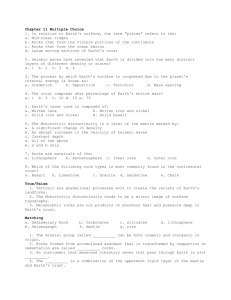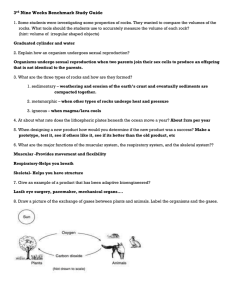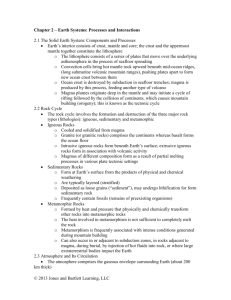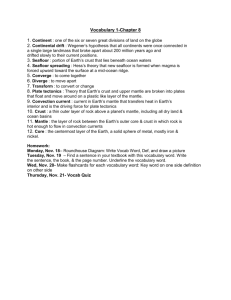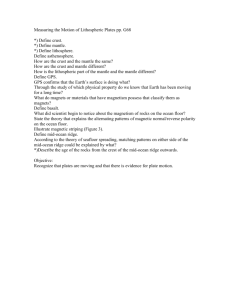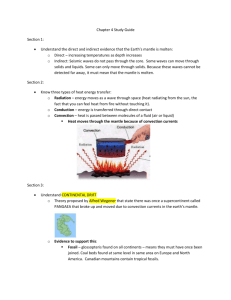PwrPt
advertisement
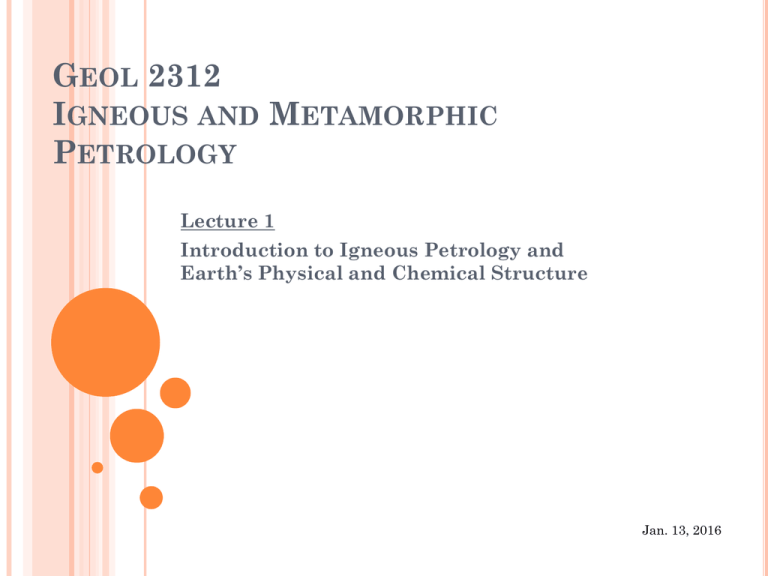
GEOL 2312 IGNEOUS AND METAMORPHIC PETROLOGY Lecture 1 Introduction to Igneous Petrology and Earth’s Physical and Chemical Structure Jan. 13, 2016 A Fundamental Dilemma to the Study of Igneous and Metamorphic Rocks and the Processes that Create Them ACCESS THE REALM OF IGNEOUS AND METAMORPHIC ROCKS IGNEOUS PETROLOGY “Study of Rocks formed by the Crystallization of Magma” Geologists as Journalists: What, Where, When, Why What do we want to know about magma? What do we want to know about crystallization processes? How do we study igneous rocks to address these questions? TOOK A WHILE TO GET HERE A.G. Werner (1787) - Developed a chronostratigraphy of the Earth’s crust that was based on progressive deposition of rocks from a gradually subsiding ocean. The theory was nearly universally accepted in the late 1700’s. Defined five crustal units: Primitive Series – crystalline rocks considered to be the first precipitates from the ocean before the emergence of land. Transition Series - more indurated sedimentary sequences that were the first orderly deposits from the ocean. Secondary Series - the remaining, obviously stratified fossiliferous rocks and certain associated "trap" rocks. These were thought to represent the emergence of mountains from beneath the ocean and were formed from the resulting products of erosion deposited on their flanks. Alluvial Series - poorly consolidated sands, gravels and clays formed by the withdrawal of the oceans from the continents. Abraham Gottlob Volcanic Series - younger lavas flows demonstrably associated with volcanic vents. Werner believed that these Werner rocks reflected the local effects of burning coal beds. 1749-1817 NEPTUNISM Interesting Interpretations: - Primitive granites, highly metamorphosed rocks, basalts flows and diabase dikes are crystalline precipitates from the universal ocean - Mountains reflect the original chaotic landscape of the earth; they are static, fixed in space and time - Volcanoes are minor, geologically unimportant elements of the crust created by the subterranean combustion of coals seams. VULCANISTS Auvergne Volcanoes , S. France Early Challenges to Werner’s theory: - Where did the water go??? - The Auvergne volcanoes rest on granite (primitive rocks)! - Italian and French scientist showed that “trap rock” interlayered with sedimentary rocks were identical to recent basalt flows and thus were formed from molten lava and were not precipitates from seawater. PLUTONISM James Hutton (1726-1797) – The Father of Modern Geology A member of the Edinburgh Oyster Club that included economist Adam Smith, mathematician John Playfair, philosopher John Hume, and chemist Joseph Black 1788. Theory of the Earth; or an investigation of the laws observable in the composition, dissolution, and restoration of land upon the Globe. Principal Concepts • The current landscape is a balance between rejuvenation (uplift) and destruction (erosion) of the earth’s surface • The earth is eternally dynamic and everchanging (“No Vestige of a Beginning, No Prospect of an End”) • The internal heat of the earth is responsible for uplift of mountains and the igneous origin of granite and basalt?; reinforced by melting experiments of Hall (1792) Melting Experiments Crystallization Experiments COMPONENTS OF SCIENTIFIC “STUDY” OBSERVATIONS/INTERPRETATIONS OF EXPERIMENTS SIMULATING THE NATURAL WORLD COMPONENTS OF SCIENTIFIC “STUDY” OBSERVATIONS/INTERPRETATIONS OF THE NATURAL WORLD COMPONENTS OF SCIENTIFIC “STUDY” OBSERVATIONS/INTERPRETATIONS OF THEORETICAL MODELS THE OF NATURAL WORLD Cobra MELTS Interface Ghiorso & Sack (1995) PHYSICAL AND CHEMICAL STRUCTURE OF EARTH HEAT SOURCES AND TRANSFER IN THE EARTH 1. Heat from the early accretion and differentiation of the Earth still slowly reaching surface 2. Heat released by the radioactive breakdown of unstable nuclides Heat transferred by: 1. Radiation – transfer to another mediuim 2. Conduction – transfer kinetic energy from hotter to colder 3. Convection/Advection – movement of material of different densities controlled by temperature and composition The Geothermal Gradient PRESSURE AND THERMAL GRADIENTS From Winter (2001) COMPOSITION OF THE EARTH How Do We Know? - Mantle Xenoliths - Seismic Data - Density Constraints - Meteorites - stony ~mantle - iron ~core - chondrites ~whole earth Plate Tectonics drives Two Stages of Crust-making 1. Mantle partially melts to make ocean crust 2. Ocean crust melts to make continental crust THE GEOTHERMAL GRADIENT Fig 1.13. Pattern of global heat flux variations compiled from observations at over 20,000 sites and modeled on a spherical harmonic expansion to degree 12. From Pollack, Hurter and Johnson. (1993) Rev. Geophys. 31, 267-280. Cross-section of the mantle based on a seismic tomography model. Arrows represent plate motions and large-scale mantle flow and subduction zones represented by dipping line segments. EPR =- East pacific Rise, MAR = Mid-Atlantic Ridge, CBR = Carlsberg Ridge. Plates: EA = Eurasian, IN = Indian, PA = Pacific, NA = North American, SA = South American, AF = African, CO = Cocos. From Li and Romanowicz (1996). J. Geophys. Research, 101, 22,245-72. PLATE TECTONICS From: quakeinfo.ucsd.edu/%7Egabi/sio15/Lecture04.html “Slab Pull” is thus much more effective than “Ridge Push” But both are poor terms: “slab pull” is really a body force (gravity acting on the entire dense slab.. The old question of whether convection drives plate tectonics or not is also moot: plate tectonics is mantle convection. The core, however, cools by more vigorous convection which heats the base of the mantle by conduction and initiates plumes (lower viscosity) MANTLE DYNAMICS Is the 670 km transition a barrier to whole-mantle convection? Maybe? Partly? No? Figure 1.14. Schematic diagram of a 2-layer dynamic mantle model in which the 660 km transition is a sufficient density barrier to separate lower mantle convection (arrows represent flow patterns) from upper mantle flow, largely a response to plate separation. The only significant things that can penetrate this barrier are vigorous rising hotspot plumes and subducted lithosphere (which sink to become incorporated in the D" layer where they may be heated by the core and return as plumes). Plumes in core represent relatively vigorous convection (see Chapter 14). After Silver et al. (1988). TECTONO-MAGMATIC ENVIRONMENTS 1. Mid-ocean Ridges 2. Intracontinental Rifts 3. Island Arcs 4. Active Continental Margins 5. Back-arc Basins 6. Ocean Island Basalts 7. Miscellaneous IntraContinental Activity kimberlites, carbonatites, anorthosites...



